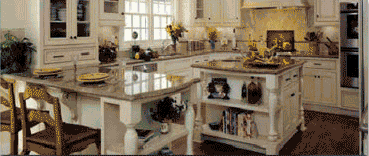

Home
Gallery
FAQs
About Us
Contact Us
Directions
The Process
Cabinetmakers




Our Process
 Selecting
and creating a finish to complement your architectural appointments is
the first step in the finishing process. Included in our service is a
consultation to help you select the perfect finish for your design.
We have a wide variety of finishes and can satisfy the most discerning
customer. Most finishes will fall into following types as described
below.
Selecting
and creating a finish to complement your architectural appointments is
the first step in the finishing process. Included in our service is a
consultation to help you select the perfect finish for your design.
We have a wide variety of finishes and can satisfy the most discerning
customer. Most finishes will fall into following types as described
below.
Upon receiving the cabinets all parts are inventoried. Hardware is removed and carefully marked (except drawer guides which are masked). Interiors are finished clear if needed and masked. Cabinets are finished and buffed to remove any over spray. Then are carefully reassembled.
Clear T-77
 Our
clear finishes consist of two coats of post catalyzed sealer and two
coats of acid catalyzed vinyl. Cabinets are lightly pre-sanded and
sanded between coats. To ensure manufacture?s specified film
thickness on all edges, all doors and drawer fonts are sprayed flat
and placed on drying racks.
Our
clear finishes consist of two coats of post catalyzed sealer and two
coats of acid catalyzed vinyl. Cabinets are lightly pre-sanded and
sanded between coats. To ensure manufacture?s specified film
thickness on all edges, all doors and drawer fonts are sprayed flat
and placed on drying racks.
We can provide any sheen between semi flat and gloss. The clear T-77 finish is excellent in resisting water and chemicals. It will not breakdown due to hand traffic. T-77 has excellent clarity, will not yellow and has good durability against marring and impacts.
Single Stage Stain
Cabinets are lightly sanded and a stain is applied to the raw wood surface. Clear T-77 finish is then applied. This process is good for Oak Mahogany Ash Walnut and other open grain woods.
Two Stage Stain

Cabinets are lightly sanded and a stain controller is applied to the raw wood surface and allowed to cure. Stain is applied to the treated surface and a clear T-77 finish is applied.
This finish is good for closed grain wood such as Maple, Cherry, Alder, Birch, etc. These species of wood have a tendency to ?blotch? when staining and this process helps control this condition. However this can only be used with light to medium color stains.
Stain Glaze
Cabinets are lightly sanded and a stain is applied to the raw wood and allowed to cure. The stained wood is sealed and a color glaze coat is hand applied. Cabinet sections are compared to each other to control color consistency. After color inspection a T-77 finish is applied.
Paint
 Cabinets are primed
with a post catalyzed surfacer. Dents, dings and holes are filled with
a two component filler. They are then sanded smooth, caulked and
recoated with surfacer. Directional lighting is used to locate
defects. Filler is applied again and sanded. A final coat of
surfacer is applied and lightly sanded. After curing, two coats of
Pigmented Conversion Varnish are sprayed on the surface. This finish
is excellent
in resisting water and chemicals. It will not breakdown due to hand
traffic. It will not yellow and has good durability against marring
and impacts. This finish is far superior to standard house paint. It
has a smooth porcelain like look and we can provide sheens levels from
satin to gloss .
Cabinets are primed
with a post catalyzed surfacer. Dents, dings and holes are filled with
a two component filler. They are then sanded smooth, caulked and
recoated with surfacer. Directional lighting is used to locate
defects. Filler is applied again and sanded. A final coat of
surfacer is applied and lightly sanded. After curing, two coats of
Pigmented Conversion Varnish are sprayed on the surface. This finish
is excellent
in resisting water and chemicals. It will not breakdown due to hand
traffic. It will not yellow and has good durability against marring
and impacts. This finish is far superior to standard house paint. It
has a smooth porcelain like look and we can provide sheens levels from
satin to gloss .
Paint Glaze
Cabinets are prepared and primed in the same process as painting. up to the conversion varnish application Sealer is sprayed over primer surfacer and then a color glaze coat is hand applied over the sealer. Cabinet sections are compared to each other to control color consistency. Sealer is sprayed over glaze coat and then a coat of Acid Catalyzed Vinyl is applied for protection and sheen.
This finish is excellent in resisting water and chemicals. It will not breakdown due to hand traffic. It will not yellow and has good durability against marring and impacts. This finish is far superior to standard house paint. It has a smooth porcelain like look and we can provide sheens levels between semi-flat to gloss.
Toner
Toner finishes are finished the same as clear finishes except that the color is added in the finish. For color uniformity care must be taken when applying this finish. Toners can be used in conjunction with other finishes to adjust over colors or to darken finishes. This type of finish can give darker results with good color uniformity.
Distressing
Distressing can be added to any finish but for best results distressing should be used in conjunction with a glaze type finish. This will highlight the distressing nuances.

Copyright © Freeman Finishing - All Rights Reserved. License #723676